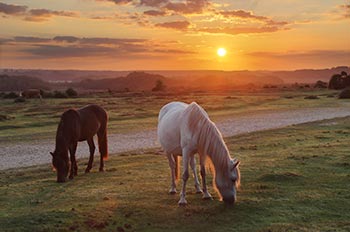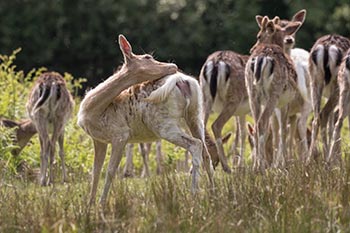For comprehensive information about the New Forest National Park
***** For information about New Forest access restrictions and related matters, check out the Forestry England website. *****
New Forest history in the landscape - an introduction
Enjoy the great outdoors! The New Forest is a marvellous outdoor museum available for all who care to take a look.
Almost wherever one walks, drives or rides in the New Forest, the landscape illustrates well the impact of man's activities over the past 3,500, or so, years. Some of the feaures - the shapes in the landscape - are really difficult to miss, whilst others sometimes take a bit of finding. But whatever your level of interest, visits to the New Forest will always be enhanced by a little knowledge of what has gone before.
Find out more
Ashley Walk Bombing Range - a reminder of deadly business in World War Two
Beaulieu Airfield - one of a number of New Forest, Second World War airfields
Bee Gardens - wild places for hives and honey
Bishop's Dyke - a simple, centuries old earthen bank and ditch that winds around a 7.25 kilometre (4½ mile) serpentine course
Bramshaw Telegraph - a Napoleonic signalling station
Bronze Age barrows (butts) - burial places from times long gone
Browse lines - created and maintained by deer and commoners' stock
Buckland Rings - an Iron Age hill fort near Lymington
Canadian Memorial - a simple wooden Cross in memory of war-time sacrifices
Castle Hill, Burley - an Iron Age Hillfort with fine views
Castle Hill, Ring and Bailey castle - a Norman fortification near Godshill
Castleman's Corkscrew - a historic railway line through the New Forest
Cut Walk - a short-cut for use by the gentry
East Boldre Airfield - the home of the New Forest Aviation School and also RFC Beaulieu, a First World War airfield
Eyeworth Pond and the Schultze Gunpowder Factory - the man-made pond is now a beautiful landscape feature
Frankenbury - the largest Iron Age hill fort in the New Forest
Hatchet Mill - a little known corn mill that ceased operating early in the 20th century
Ice Houses - reminders of how ice was stored in the days before fridges were available
Iron Age hill forts - a general overview of New Forest hill forts
Irons Well - its healing qualities brought visitors from afar
Knightwood Oak, Eagle Oak and other ancient New Forest trees - at the very heart of the Forest
The Park Pale and Lyndhurst Old Park - the remains of a medieval deer park
Pollard trees and Coppice trees - woodland management through the ages
Portuguese Fireplace - left by wartime helpers in the woods
Re-seeded grasslands - open spaces cropped in times of trouble
Rhinefield Ornamental Drive, Blackwater Arboretum and Rhinefield House - majestic trees tower high above
Royal Hunting Lodges and Church 'place' names - humble earthwork remains closely associated with church 'place' names
Rufus Stone - a memorial to Red Rufus
Second World War airfields - an introduction
Stag Parks - a brief history
Stoney Cross Airfield - its wartime role
Stoney Cross Airfield - a detailed look at the airfield
Stoney Cross Airfield - a walk around the airfield
Stubby Copse Fort - an Iron Age hillfort deep in the woods
Turnpike milestones and toll roads - tell-tale reminders of the early days of rapid transport
Volunteer rifle ranges and the Rifle Volunteer Corps - places where ordinary folk learnt the skills of war
Wood-banks - moss-clad survivors from an earlier age
Woodland Inclosures - a bit of history - places of timber production, and valuable wildlife habitats
Quick linksNew Forest Explorers Guide - home page
More links
New Forest heritage - introduction
New Forest Heritage
Search this site
** New Forest ponies and other animals**

Sadly, 58 animals were killed - 35 ponies, 13 cows, 8 donkeys and 2 sheep, whilst a further 32 were injured - 3 pigs, 9 donkeys, 11 cows and 9 ponies.
(Forty-three accidents occurred in daylight, 15 at twilight and 101 in the dark. Twenty-seven accidents were not reported by the driver involved).
Here's just one horrific example - Three donkeys killed in collision with van at notorious New Forest blackspot (Advertiser and Times)
** Always take care when driving **
New Forest seasonal highlights
January Honeysuckle, an early harbinger of spring, shows signs of new growth.
Bird sounds, great tit calls and mistle thrush song, for example, are increasingly heard as the days lengthen and spring rapidly approaches.
Foxes breed during the early months of the year. Their presence is betrayed by barks after darkness falls.
February
Great grey shrikes hunt over heathland from tree-top vantage points and other perches.
Grey squirrels are often best seen in winter when deciduous trees are devoid of leaves.
Red Admirals and other butterflies that over-winter as adults may be on the wing on warm, bright days.
Roe deer antlers continue to develop - they are cast and re-grown annually.
The Glorious New Forest


Marvellous landscapes, marvellous wildlife

